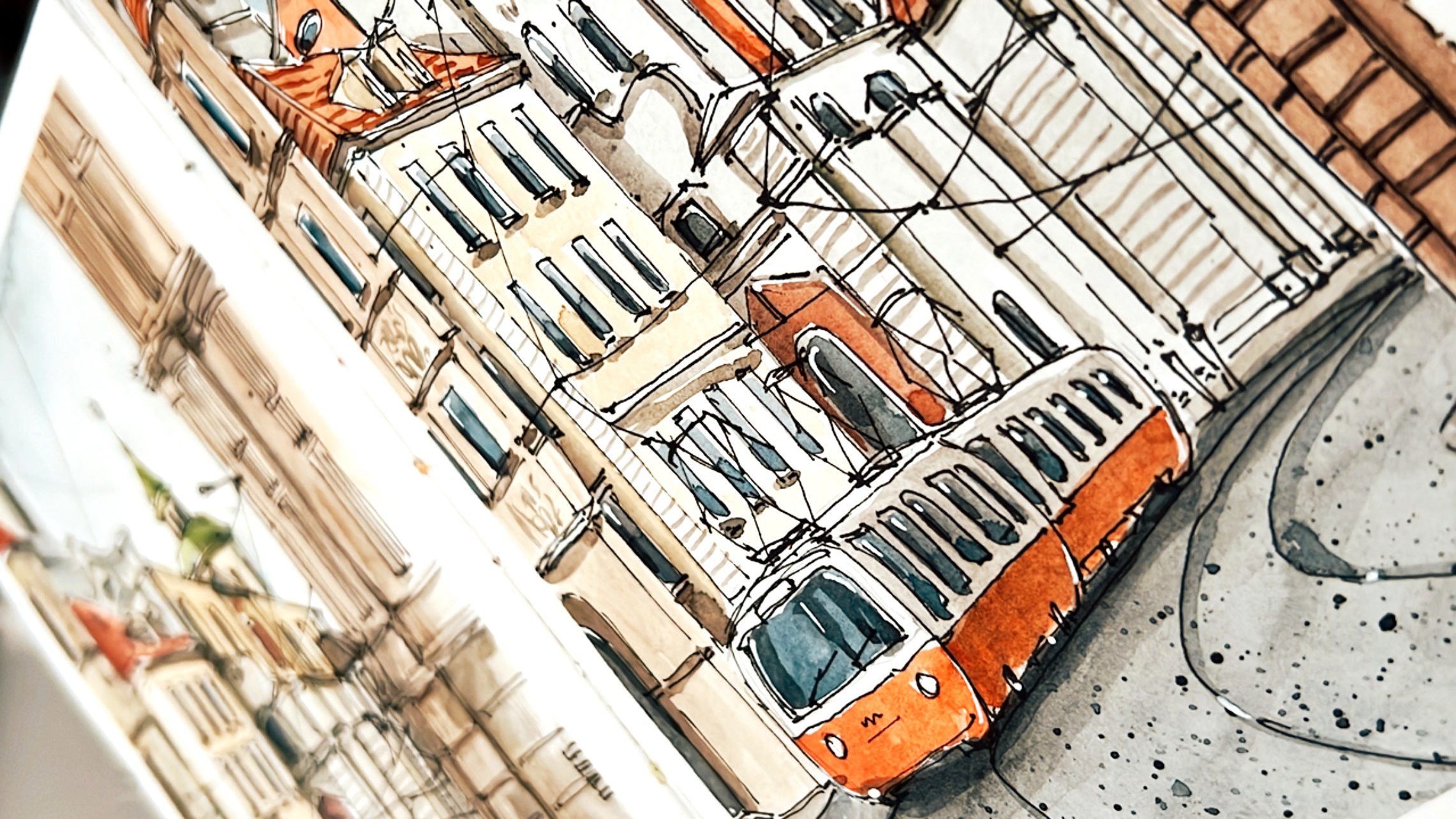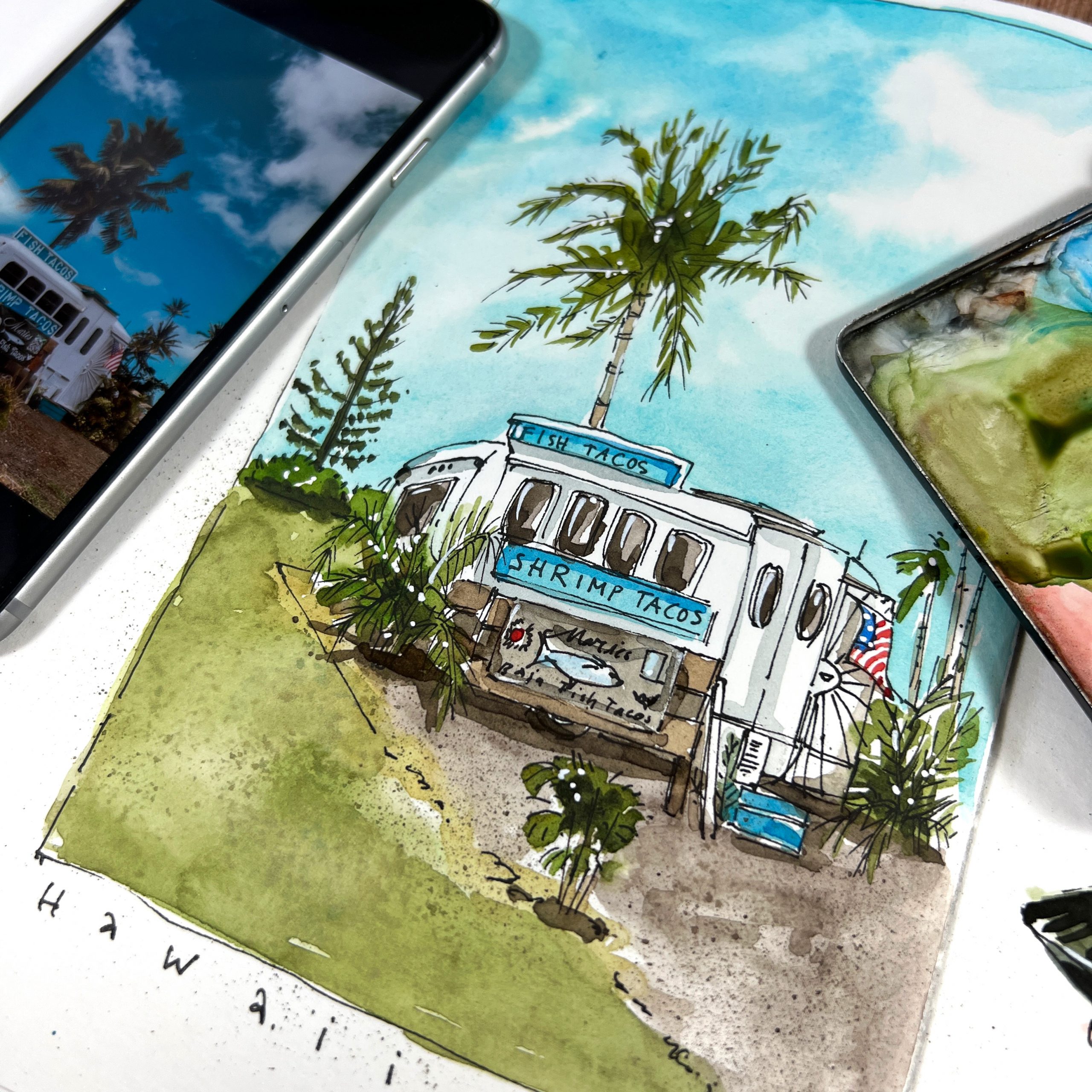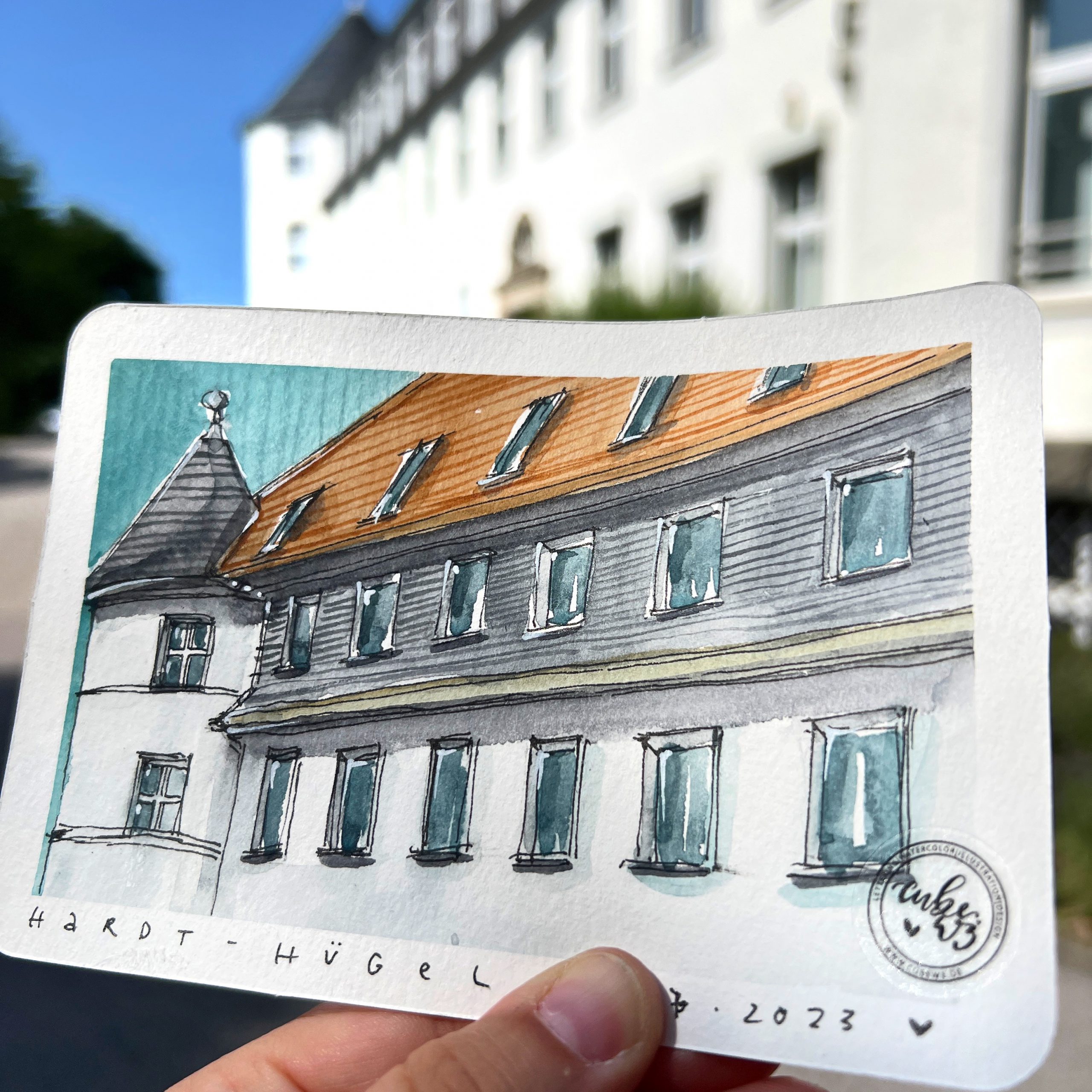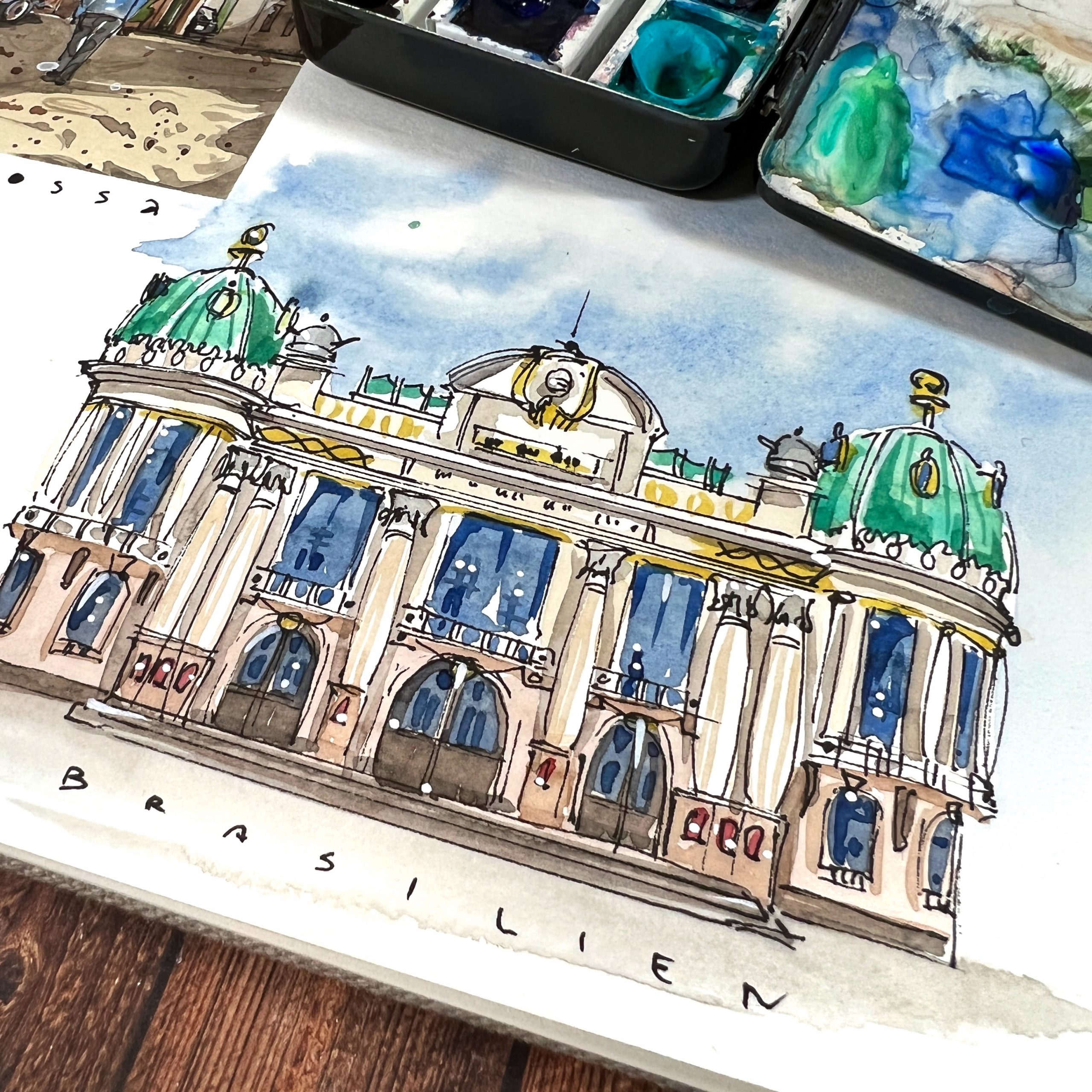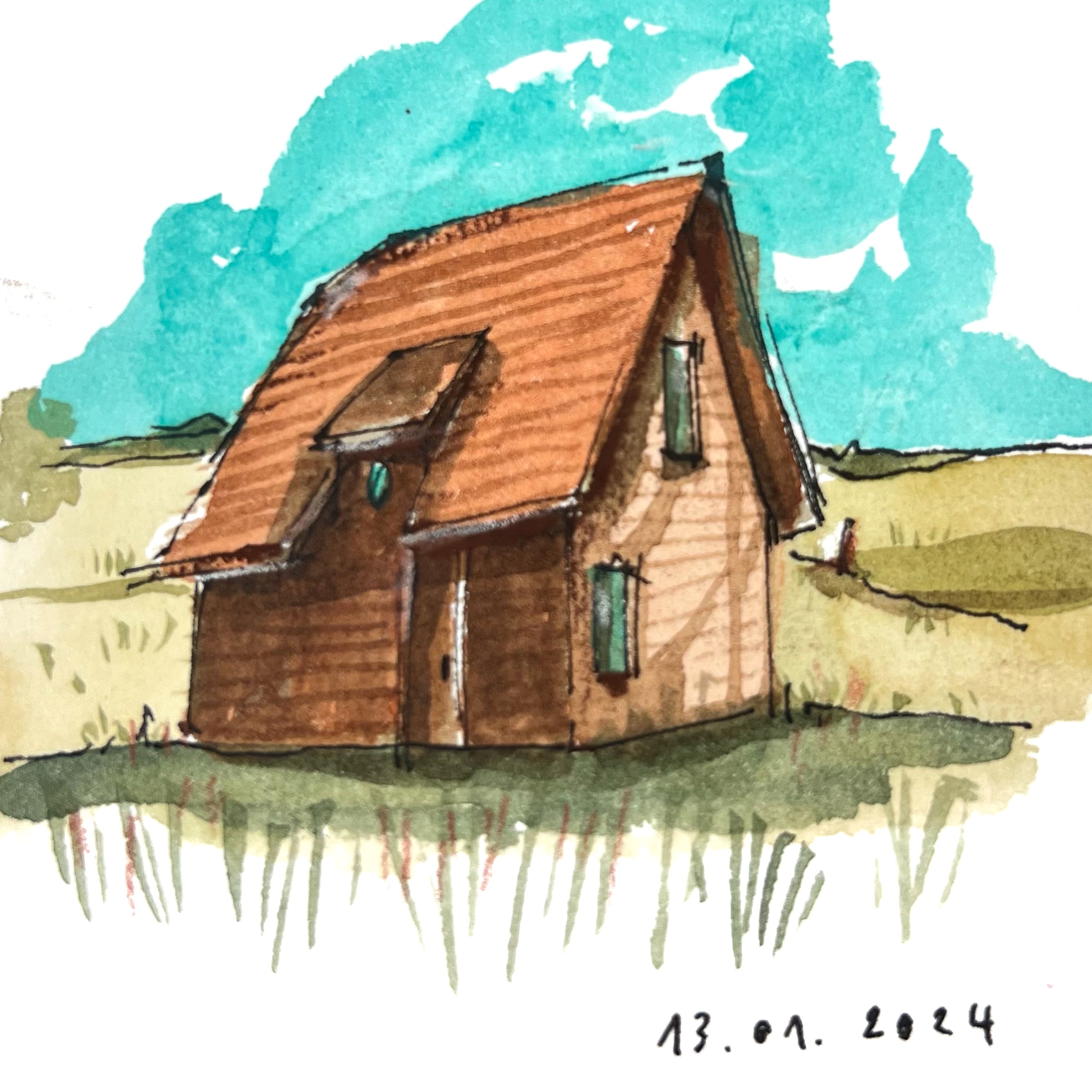Thank you, Tanja, for taking the time to join our short interview. You are a well-known face in the German-speaking community. Always in a good mood and always cheerful. But for everyone else who doesn’t know you yet, it would be great if you could briefly introduce yourself.
Who are you, what do you do and where are you from?
Thank you so much for the compliment. I am Tanja Werner aka cube.w3, fondly known as Cubie. I’m 45 years young, trained in media design and successfully completed a master’s degree in architecture. I’ve been on social media for six years now under cube.w3, mainly on Instagram. There I share daily insights into my creative world, urban sketching with watercolour, ink and coloured pencils. I’ve been sketching for as long as I can remember. And then the world of architecture brought out the sketcher in me through “drawing design”. Today I give watercolour/urban sketching live workshops throughout Germany and Switzerland, both indoors and outdoors. And increasingly, of course, online courses via Zoom or Patreon.
How did your journey into the world of lettering and creative design begin? Have you always been creative?

From a very early age, I was looking for creative forms of expression, following the example of my mother, who loved to paint in oils when I was a child. Emulating her helped me to discover my creative possibilities, whether at school, on the road or at home. The appearance of my own handwriting was the first early conscious creative influence. Afterwards, I engaged in a wide variety of creative projects at school, such as a one-year professional internship in the decoration department of the Wuppertal Opera House, trained as a media designer at school and, after graduating from high school, a Master of Science in Architecture.
How can we imagine a normal day in your life as an artist?
Just like my everyday motto “Always have your painting materials with you!”, my day also looks like this, no matter where I am or where I’m travelling, I always have a pen, brushes, paints and my sketchbook with me. Because every time slot, whether in the doctor’s waiting room, after cancelled appointments or relaxing on the sofa, is used to capture my surroundings, at least in simple lines. In this way, I hardly ever run out of motifs, because everyday life offers pretty much every imaginable template. I’m happy that I don’t seem to run out of ideas so quickly and as my husband also works in the creative field, we can constantly exchange ideas and benefit from each other. Of course, the constant planning and preparation of online and live workshops is also part of the daily routine. This requires organisation and administrative work, but finding the creative content and unlimited topics that I am able to convey to the participants makes up for all the hard work.
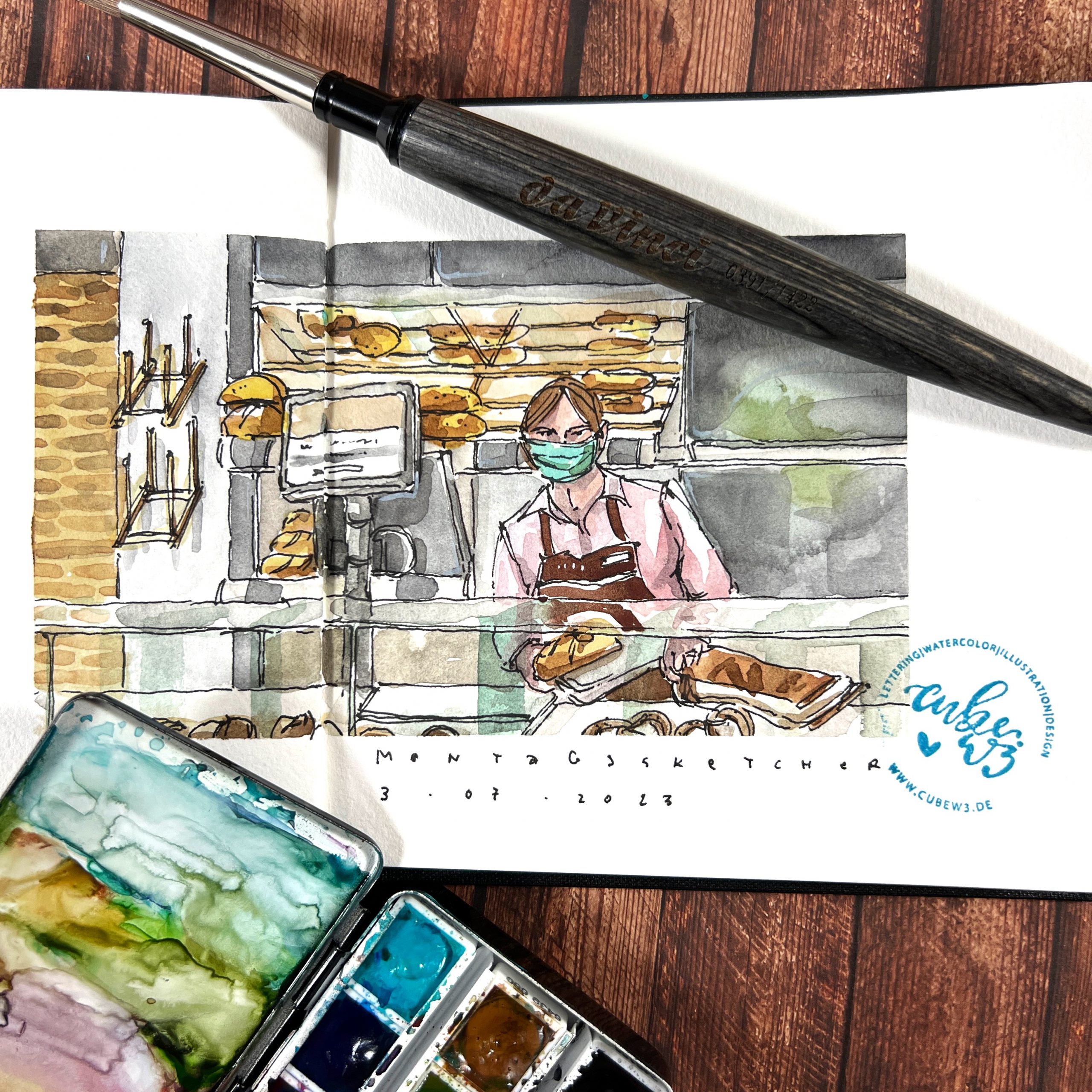


Besides you, there are also other family members who paint or are creative: your mum paints and your brother is a tattoo artist. Has creativity always run in your family, or have you infected everyone?
It really does run in the family; as I said, my mother has been involved in oil painting and watercolour for a long time and there was always something being made, redesigned or creatively discussed in our family and throughout our home. My older brother only discovered his creative streak a little later, but has since immortalised himself as an extremely successful tattoo artist on various human bodies, which regularly makes a deep impression on me.
It’s hard to imagine you without your “Off Man”. You are a lovely couple. How did the name Off Man come about?
The “Off Man” is part of cube.w3. His structured organisation of the framework conditions allows me to concentrate freely and openly on the creative aspects. It wasn’t actually planned that way, it developed more coincidentally. While sketching various building objects outdoors as motifs for my followers, I became increasingly aware of how difficult it is to draw and film at the same time. Fortunately, my husband is a media designer who specialises in audiovisual media and has been working in film and video for years. So I asked him if he could do the same for me when I was sketching. Since then, he’s been doing it with real passion, but on the condition that he doesn’t have to act in front of the camera himself. He tells the followers off-camera about the location, the subject or my approach, for example. He interviews me about my materials, my techniques or the individual work steps. As you can’t see him doing this, the term “Off Man” has established itself and is often used in different ways.
Have you ever had an artist as a role model from whom you have learnt something and who has influenced your work? Were there certain styles that particularly inspire you?
For me, it was always essential to sketch like the urban sketchers who are currently en vogue. Loose, free and individual in appearance, with a light stroke and a quick result. Like the working method in architecture, the design already contains the most important ideas. Felix Scheinberger influenced me very early on and became one of my role models, as he combines line and watercolour in a visualising way. That has always been my approach too.
Your artistic work is both digital and analogue. What do you enjoy more and why, and how do these two worlds differ?
Even though I mainly offer digital courses and tutorials, my actual work remains analogue. Followers may see it as a digital representation, but the creation process remains analogue in terms of craftsmanship. The real sketching in the live workshops creates a very nice analogue feeling throughout, I get direct input from the people around me. I can experience in real life how they take the explanations and process them further. I can respond to everyone individually and share my progress with them directly. It is simply an inspiring experience to help the participants develop their creative skills.
Now we’re curious. How do you go about choosing colours and materials?
When you draw every day, you tend to use the material that you trust without limitation. For me, this means that my colours never really change, they give me security because I know them in every respect and know how they react. I always use Schmincke colours, usually Horadam. In my small travel watercolour box with only 12 half pots of paint, I choose the colours based on the basic colours (CMYK), a remnant of my training as a media designer. That’s why a neutral grey is also included. I also need colours that can be used directly in urban life, such as Juice Green or Burnt Umber. The colours for mixing skin tones, from light to dark, are also always available, such as Alizarin Crimson, Siena Natural or Glaze Orange. As a more graphic element, Cobalt Turquoise must be included, which is probably my favourite colour. It often adds the finishing touch and has a wonderfully complementary effect. When choosing my brushes, I stay true to the DaVinci brand, preferring the wash brush with a French weave and human hair. I need a lot of hair for a lot of water and colour, preferably with a very fine tip for the details.


What is important to you in a paper? And of course we would also like to know your favourite Hahnemühle paper?
I prefer to work on paper that is not too rough, such as hot pressed paper. I like my sketches to appear almost as if they were printed. If possible, I use 100% cotton, but my paper should dry relatively quickly, as I mainly draw on the go and have little time available. My favourite paper for this reason is the Watercolour Book 100% Cotton from Hahnemühle. I use it in several formats at the same time for all occasions, whether briefly in my handbag or outdoors with a seat.
How would you describe your style and what characterises your work?
My style is rather rough, my strokes with fountain pen as well as brush are very dynamic, targeted and live from several layers that create 3D in the end.


What motivates you to share your creative projects online and what importance do the interactions with your followers have for you?
For me, online work, mainly via Instagram, means targeted acquisition and effective advertising to publicise my workshops and activities. I always enjoy passing on my knowledge and skills and experiencing and sharing the successes of my followers. I enjoy personal dialogue and love getting to know so many different people and creative minds.

Do you recognise artistic blockades? And if so, how did you get out of it?
I’m very lucky that I’ve rarely had artistic blockages so far, but when I have had something like a low or a tired phase, a small change of location, new impressions, different people and views have always helped me. The “Off Man” usually takes me by the hand and I just get out and about.
Why did you decide to offer workshops and even write books with helpful guides?
Over many years, I have gathered a lot of experience, knowledge and creative potential in the various techniques. It is the certainty of not only being able to store all of this in my head in a limited way, but to offer it to other people for use and to work creatively myself – a win-win situation, so to speak. Everyone who wants to should benefit according to their own taste, willingness and ability. What a wonderful feeling!
We’re curious to know what’s on your agenda for the future? Do you already have projects or goals in mind that you are pursuing in the future?
In addition to the existing workshop themes and locations, two new workshop variants have been added this year: Urban Sketching Indoor and the fairytale-like Colour Your Tale. In the future, further themes will be added, as well as more locations in Europe. And of course I’m always happy to receive projects, ideas or suggestions that haven’t yet been finalised.


